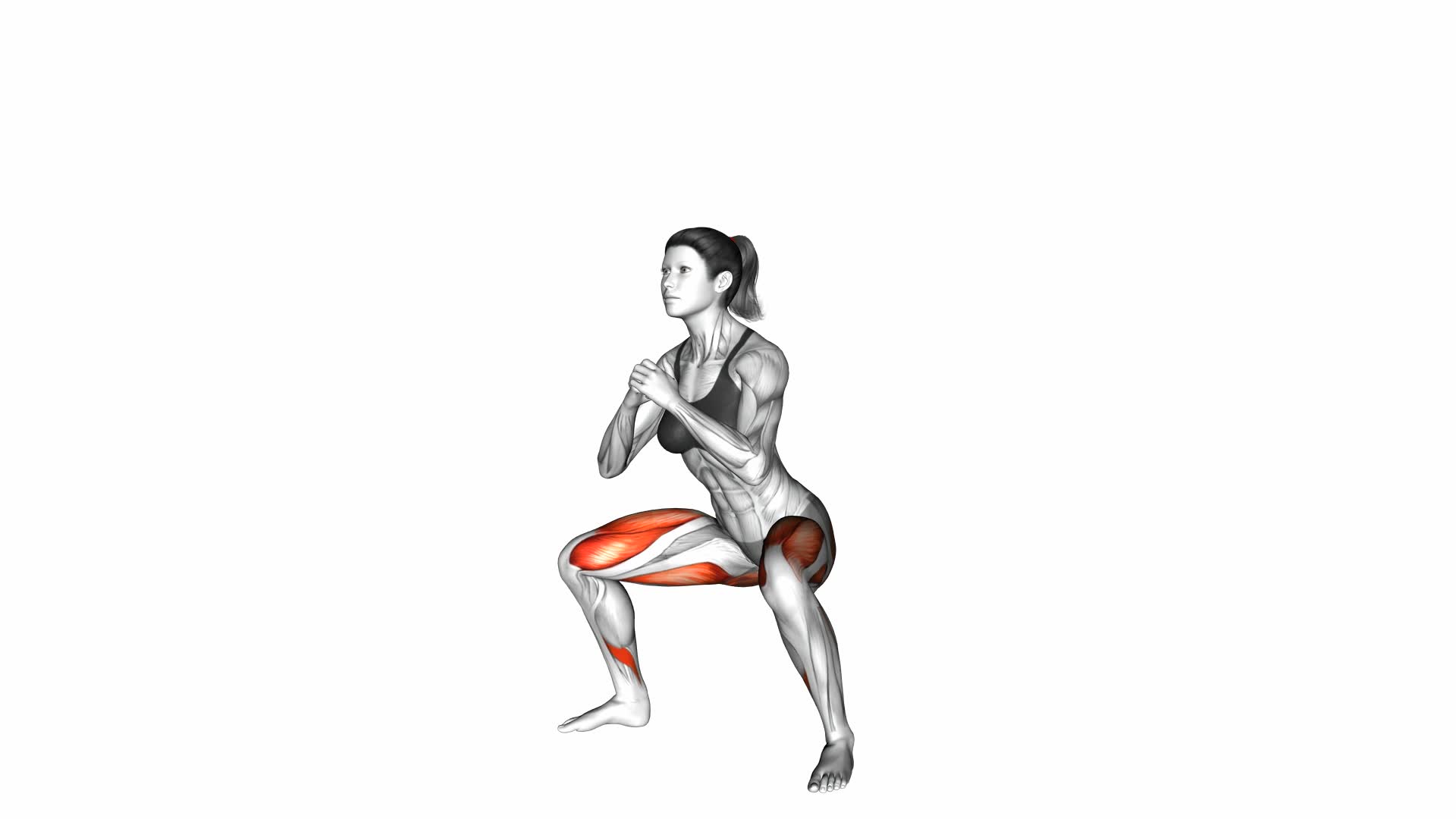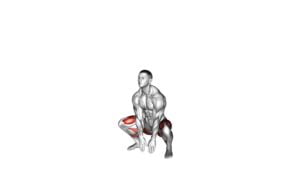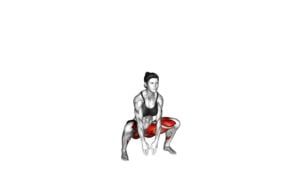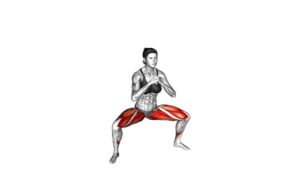Sumo Squat – Video Exercise Guide & Tips

Looking to tone your lower body and strengthen your legs? Look no further than the sumo squat.
Watch This Exercise Video
In this video exercise guide, we'll show you the proper form and technique to get the most out of this effective workout. Avoid common mistakes, learn tips for increasing intensity, and discover variations to challenge yourself.
Get ready to squat your way to stronger, leaner legs with our sumo squat workout routine. Let's get started!
Key Takeaways
- Sumo squats target multiple muscle groups, including the quadriceps and glutes.
- Proper form and technique are important for maximizing the benefits of sumo squats.
- Common mistakes to avoid include incorrect feet position and weight distribution errors.
- To increase intensity, incorporate resistance bands or dumbbells and vary the exercises and variations.
Benefits of Sumo Squats
Sumo squats offer a range of benefits that can improve your lower body strength and overall fitness. By incorporating sumo squats into your workout routine, you can target multiple muscle groups and enhance your overall physical performance.
One of the primary muscles targeted in sumo squats is the quadriceps. These are the muscles located at the front of your thighs, responsible for knee extension. The wide stance and deep squatting position of sumo squats engage the quadriceps more intensely than traditional squats.
In addition to the quadriceps, sumo squats also work the glutes. The gluteus maximus, medius, and minimus are all activated during this exercise, helping to shape and strengthen your buttocks.
To incorporate sumo squats into a full body workout routine, you can perform them as part of a lower body or leg day. Begin by standing with your feet wider than shoulder-width apart, toes turned out slightly. Lower your body by bending your knees and pushing your hips back, keeping your chest lifted and core engaged. Then, return to the starting position by pushing through your heels.
Sumo squats can be a great addition to your fitness routine, targeting multiple lower body muscles and improving overall strength. Now, let's move on to the subsequent section about proper form and technique to ensure you get the most out of this exercise.
Proper Form and Technique
To ensure you get the most out of your sumo squats, it's important to focus on proper form and technique. One crucial aspect of preparing for any exercise is a proper warm-up. Before starting your sumo squats, spend a few minutes doing dynamic stretches like leg swings or hip circles to loosen up your muscles and increase blood flow to the targeted areas. This will help prevent injuries and improve your overall performance.
When performing sumo squats, it's essential to pay attention to your knees to prevent injuries. Start by standing with your feet wider than shoulder-width apart and toes pointed slightly outward. As you lower into the squat, make sure your knees are tracking in line with your toes. Avoid letting your knees collapse inward or extend past your toes, as this can put unnecessary stress on your knee joints. Engage your core and maintain a neutral spine throughout the movement.
Additionally, it's crucial to maintain proper alignment and balance during sumo squats. Keep your chest lifted, and your weight evenly distributed between your heels and the balls of your feet. This will help activate the correct muscles and prevent strain on your knees.
Common Mistakes to Avoid
When performing a sumo squat, it's important to be mindful of common mistakes that can hinder your progress.
One common mistake is improper feet positioning, which can throw off your balance and alignment.
Another mistake to avoid is incorrect weight distribution, as this can put unnecessary strain on your joints and muscles.
Lastly, be cautious of depth and form issues, as going too shallow or not maintaining proper form can limit the effectiveness of the exercise.
Feet Position Mistakes
Avoid making the mistake of positioning your feet incorrectly while performing the sumo squat exercise. One common error is placing your feet too close together. This can reduce stability and limit the range of motion in your squat. To correct this, make sure your feet are wider than hip-width apart, with toes pointing slightly outwards.
Another mistake to avoid is allowing your knees to cave inwards during the squat. This can strain the knees and lead to injury. To maintain correct alignment, focus on pushing your knees outwards in line with your toes throughout the movement.
Weight Distribution Errors
Make sure you distribute your weight evenly to avoid common mistakes in the sumo squat exercise.
One of the most common errors in weight distribution is leaning too far forward or backward. When you lean forward, you put excessive strain on your lower back and risk losing balance. On the other hand, leaning backward shifts the weight onto your heels, making it difficult to maintain stability.
To correct these mistakes, focus on keeping your weight centered and distributed evenly between your feet. Engage your core muscles to maintain a stable posture throughout the exercise.
By correcting weight distribution errors, you can perform sumo squats more effectively and reduce the risk of injury.
Now, let's move on to the next section about depth and form issues.
Depth and Form Issues
To ensure proper form and avoid common mistakes, it's important to focus on the depth and form of your sumo squat exercise. Proper depth is crucial for engaging the right muscles and maximizing the benefits of this exercise. Here are some key points to keep in mind:
- Depth and Form Importance:
- Aim to lower your hips until your thighs are parallel to the ground.
- Maintain a straight back and avoid rounding your shoulders.
- Keep your knees in line with your toes throughout the movement.
By paying attention to these aspects, you can ensure that you're performing sumo squats correctly and effectively.
It's also important to note that beginners may need to modify the exercise to suit their fitness level. This can include using a wider stance or performing the exercise with bodyweight only.
Now, let's move on to some tips for increasing the intensity of your sumo squat workout.
Tips for Increasing Intensity
Increase the intensity of your sumo squat by incorporating resistance bands or holding a dumbbell. Adding resistance can help to challenge your muscles and make the exercise more effective. You can attach resistance bands around your thighs or hold a dumbbell between your legs as you perform the sumo squat. This will increase the load on your muscles and make them work harder.
Another way to increase the intensity of your sumo squat is by incorporating it into a full body workout. By combining the sumo squat with other exercises such as lunges, push-ups, or planks, you can create a more challenging and comprehensive workout routine. This will engage multiple muscle groups and help you burn more calories.
Incorporating sumo squats into a full body workout is a great way to make the exercise more intense and maximize its benefits. It allows you to target different muscle groups and keep your workout routine varied and interesting. By continuously challenging your body with different exercises and variations, you can continue to progress and see improvements in both strength and endurance.
Now that you know how to increase the intensity of your sumo squat, let's move on to the next section and explore some variations to challenge yourself even further.
Variations to Challenge Yourself
To further challenge yourself and continue building strength and endurance, try incorporating these variations into your sumo squat routine:
- Advanced Modifications: Once you've mastered the basic sumo squat, it's time to take it up a notch. Try adding a jump to your squat, exploding upwards as you come out of the squat position. This won't only engage your leg muscles even more, but also give your cardiovascular system a good workout.
- Equipment Options: If you want to add some resistance to your sumo squats, consider using a kettlebell or a dumbbell. Hold the weight in front of your chest as you perform the squat, keeping your core engaged and your back straight. This will challenge your muscles even further and help you develop more strength and stability.
- Plyometric Variations: Plyometric exercises are explosive movements that can take your sumo squats to the next level. Try incorporating jump squats into your routine, where you start in a sumo squat position and jump explosively off the ground, then land softly back into the squat. This won't only work your leg muscles, but also improve your power and agility.
Sumo Squat Workout Routine
For an effective Sumo Squat workout routine, you can incorporate a variety of exercises to target different muscle groups and maximize your results. The Sumo Squat itself is a powerful exercise that primarily targets the muscles in your lower body, including your quads, hamstrings, glutes, and calves. It also engages your core muscles for stability and balance.
To add more variety to your routine and challenge yourself, you can try different variations of the Sumo Squat. One variation is the Sumo Squat with a Pulse, where you perform a small pulsing motion at the bottom of the squat to intensify the workout. Another variation is the Sumo Squat with a Dumbbell, where you hold a dumbbell at your chest or by your sides to add resistance. This variation helps to increase the strength and definition of your muscles.
Incorporating Sumo Squat variations into your workout routine can provide several benefits. Firstly, it helps to prevent boredom by adding variety to your routine. Secondly, it allows you to target different muscle groups and challenge them in different ways. Lastly, it helps to improve your overall strength, endurance, and flexibility.
Remember to always maintain proper form and technique when performing Sumo Squats and their variations. Start with lighter weights and gradually increase the intensity as your strength improves. With a well-rounded Sumo Squat workout routine, you can achieve your fitness goals and enjoy the many benefits of this effective exercise.
Frequently Asked Questions
How Many Calories Does a Sumo Squat Burn?
Sumo squats are an effective exercise for burning calories. By engaging multiple muscle groups, such as your quadriceps, hamstrings, and glutes, sumo squats can help you burn a significant amount of calories.
Additionally, the wide stance and lowered center of gravity in sumo squats increase the intensity, resulting in a higher calorie burn compared to traditional squats.
Incorporating sumo squat variations into your workout routine can provide great benefits for overall fitness.
Can Sumo Squats Help to Improve Flexibility?
Sumo squats can definitely help improve flexibility, particularly in your hips. By performing this exercise, you can increase hip mobility and enhance your range of motion.
Athletes can benefit greatly from sumo squats, as they require a wider stance and target different muscles compared to regular squats. Incorporating sumo squats into your routine can help you become more agile and improve your overall athletic performance.
Can Sumo Squats Help to Strengthen the Core Muscles?
Sumo squats are an effective exercise for strengthening your core muscles. By performing sumo squat variations, you can target your abdominals, obliques, and lower back muscles. These exercises engage your core to maintain stability and balance throughout the movement.
Athletes can benefit greatly from incorporating sumo squats into their training routine, as a strong core is essential for optimal performance in various sports.
Are Sumo Squats Safe for People With Knee or Hip Issues?
Sumo squats may not be safe for individuals with knee or hip issues. It's important to prioritize your safety and listen to your body.
If you have knee or hip issues, consider modifying the sumo squat or opting for alternative exercises that are less stressful on those joints.
Always consult with a healthcare professional or a certified trainer who can guide you in finding the best modifications or alternative exercises for your specific needs.
How Often Should Sumo Squats Be Included in a Workout Routine?
To determine how often to include sumo squats in your workout routine, consider your fitness goals and overall program. Sumo squats can be a great lower body exercise for strength and muscle development.
Aim to include them 2-3 times a week, allowing for adequate rest between sessions. Remember to vary your sumo squats by using different foot positions or adding weights to challenge your muscles in different ways.
Conclusion
In conclusion, incorporating sumo squats into your workout routine can offer numerous benefits, including increased lower body strength and improved hip mobility.
By focusing on proper form and technique, avoiding common mistakes, and gradually increasing intensity, you can maximize the effectiveness of this exercise.
Additionally, experimenting with variations can help you challenge yourself and prevent plateaus.
Consider adding sumo squats to your next workout for a powerful lower body workout.

Author
Years ago, the spark of my life’s passion ignited in my mind the moment I stepped into the local gym for the first time. The inaugural bead of perspiration, the initial endeavor, the very first surge of endorphins, and a sense of pride that washed over me post-workout marked the beginning of my deep-seated interest in strength sports, fitness, and sports nutrition. This very curiosity blossomed rapidly into a profound fascination, propelling me to earn a Master’s degree in Physical Education from the Academy of Physical Education in Krakow, followed by a Sports Manager diploma from the Jagiellonian University. My journey of growth led me to gain more specialized qualifications, such as being a certified personal trainer with a focus on sports dietetics, a lifeguard, and an instructor for wellness and corrective gymnastics. Theoretical knowledge paired seamlessly with practical experience, reinforcing my belief that the transformation of individuals under my guidance was also a reflection of my personal growth. This belief holds true even today. Each day, I strive to push the boundaries and explore new realms. These realms gently elevate me to greater heights. The unique combination of passion for my field and the continuous quest for growth fuels my drive to break new ground.







